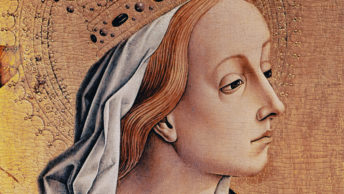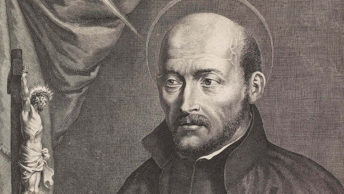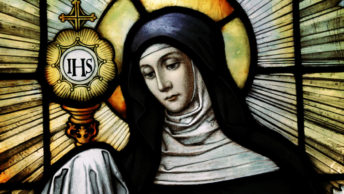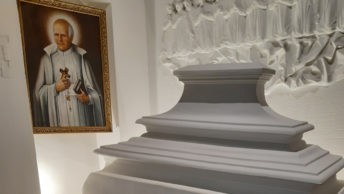Writing a homily for All Saints Day can be a real challenge for a priest. Many have labored unsuccessfully for a proper analogy. Regarding the Church’s canonized saints as the Catholic equivalent of electing a baseball player to its Hall of Fame is one sports analogy that seemed to have worked. The saints are the Church’s spiritual athletes, who played the game of life with the practiced skills of faith, hope, and charity.
THE CATHOLIC HALL OF FAME
Mother Teresa is just one step away from entering the Catholic Hall of Fame. The hagiography of writing about the saints, even in today’s cynical climate, tends to sanitize their lives so that they bear little resemblance to real people. Some writers make the canonized so holy that they appear more like plastic versions of real people.
This is in stark contrast to writers in the Middle Ages, who took a more candid approach to writing about the Church’s heroes. Thomas J. Craughwell’s 2006 book, Saints Behaving Badly, follows in their footsteps. He exposes the sins and crimes of dozens of canonized saints before divine grace intruded in their lives. The libertine activities of St. Augustine are already legendary in the Church. Obscure saints with sordid pasts include St. Olga who unleashed a bloodbath on her husband’s assassins in the 9th century.
Hollywood’s approach to its glitterati is similar. Its columnists wait anxiously for the starlet of the month to fall victim to the seductive attractions of living life on the wild side. With the publication of Mother Teresa: Come Be My Light, the secular keepers of the cultural flame believe they have found the religious equivalent of a night on the town for Paris Hilton or Britney Spears. Her book of private letters revealed that this saintly woman suffered from terrible doubts and feelings of spiritual dryness and loneliness that plagued her most of her adult life.
Her dark revelations created a feeding frenzy among those who are wont to seize any excuse they can for denigrating the Catholic Church and its public figures. Secularists and atheists alike have misinterpreted Mother Teresa’s private thoughts as irrefutable proof that the Church’s most visible holy woman was a hypocrite who lacked faith in God.
Militant atheist Christopher Hitchens called the future saint a fraud, a fundamentalist, and even a crypto-atheist. In fulfillment of her worst fears, Hitchens had the temerity to call Mother Teresa a media darling who did charity works for the praise it brought her. In a screed for Newsweek, he said Light proved that she was no more exempt from the realization that religion is a human fabrication than any other person.
A CALL INSIDE A CALL
Mother Teresa, who died on September 5, 1997, was the daughter of an Albanian grocer. She joined the Loreto Order at age 18 and began working in the Calcutta slums. On September 10, 1946, the day celebrated by the Missionaries of Charity as Inspiration Day, while riding a train to Darjeeling to make a retreat, Sister Teresa heard a call within a call. She was to give up her life with the Sisters of Loreto and follow Christ into the slums to serve him among the poorest of the poor.
In 1947 she started the Missionaries of Charity, which care for the blind, aged, lepers, crippled and the dying. Hers was a simple faith that resided in her deep desire to see Jesus in every human being. I say to myself, this is hungry Jesus. I must feed him. This is sick Jesus…I serve because I love Jesus.
English convert Malcolm Muggeridge observed that when the eighteen-year-old Agnes Gonxha Bojaxhiu left her family to join the Sisters of Our Lady of Loreto, it was the end of her biography and the beginning of her life. On October 19, 2003, Mother Teresa of Calcutta (1910-1997) was beatified in Rome. During the three-and-a-half-year investigation into her cause, every aspect of her life was studied for evidence that she was worthy of canonization. With the revelations of her letters, it appears that her biography resumes.
A POSTHUMOUS MINISTRY
Her letters have shed new light on the intensity of her religious devotion. The book was compiled and edited by Mission of Charity’s Father Brian Kolodiejchuk. It promises to rank with The Confessions of St. Augustine and Thomas Merton’s The Seven Story Mountain as an autobiography of spiritual depth. The Jesuit author Father James Martin cited the book as a written ministry of the interior life for Mother Teresa. He predicted that hers would be a posthumous ministry to all Catholics who have experienced doubts about the faith and God’s love for them.
Spanish Cardinal Julian Herranz, a member of the Congregation for Saints’ Causes, reminded the world that Christ experienced a similar spiritual trial in the Garden of Gethsemane and on the Cross. Her moments of weakness are definitive proof of the greatness of faith of Blessed Mother Teresa and take nothing away from her holiness.
Mother Teresa accepted her doubts as part of God’s Divine will for her. The irony behind her letters is that the world has watched in awe of her lifelong devotion to the poor with little hint of her internal suffering. Mother Teresa worked so closely in a world of abject poverty that she often was overwhelmed by the temptation of how a kind and loving God could allow such suffering to exist. The more of their sufferings she assumed, the more she felt that she was without God. In the face of her doubts, she adopted a blind faith that allowed her to persevere in her service to God and the poor. Her doubts became the wood of her interior cross.
THE CHALICE OF PAIN
It is not difficult to understand the source of Mother Teresa’s spiritual suffering. The old adage warned the faithful to be careful of what they prayed for because they might get it. In 1951 Mother Teresa fervently prayed to join in Jesus’ suffering on the Cross. She wrote that the Passion was the only aspect of Jesus’ life in which she wanted to fully partake. She wanted to drink from his chalice of pain. Jesus answered her prayer with some of the dark feelings of loneliness and abandonment that had accompanied His own suffering on His Cross.
Years after her doubts had started, Mother Teresa asked Father Joseph Neuer, a noted theologian whom she met in the late 1950s for his counsel. He told her that there was no human remedy for her spiritual condition and she should not feel responsible for her feelings. He advised her that her feelings of abandonment mirrored Jesus’ feelings in the Garden and on the Cross. Her craving for God was a sure sign of His hidden presence in her life. Mother Teresa had never realized that sharing His Passion would include the mental anguish He suffered on the Cross when He cried out to the Father, My God, My God, why have You forsaken Me. Father Neuer reminded her that all saints experience a Garden of Gethsemane. Like Jesus they all beg to be spared this agony of the soul.
Mother Teresa’s mental anguish as evidenced in her book is best explained through the idea of the dark night of the soul. In the dark recesses of her troubled soul, she was hounded by terrible thoughts that God seemed absent, heaven empty, and bitterest of all, her own suffering seemed to count for nothing.
A DARK CLOUD
Mother Teresa was not alone in her spiritual darkness. In the history of Christian mysticism there have been many accounts of divine darkness. It is an ancient doctrine that God dwells in inaccessible light, a light so blinding that it veils the divine glory in a dark cloud of unknowing. Some of the greatest saints have endured what St. John of the Cross called the dark night of the soul. The dark night of St. Paul of the Cross, an 18th century monk, lasted 45 years. St. John of the Cross saw his dark night of the soul, not as Divine abandonment but as a purgative expression of God’s love. Like Mother Teresa, St. Catherine of Siena and St. Teresa of Avila realized that the agony of doubt and desolation is a way of sharing in Christ’s Passion.
Saint Therese of Lisieux, Mother Teresa’s patron saint, serves as an interesting parallel. She entered a Carmelite cloister at 15 and died only nine years later of tuberculosis. Her spiritual reputation, according to Newsweek, was based on her spiritually cheerful biography, published posthumously, The Life of a Soul. Later the truth came out that her own sister Pauline, the head of the convent, had expunged all the sickbed entries where Therese had described her spiritual dryness and how she feared the loss of her faith.
Like another saint in the making, Bishop Fulton J. Sheen, Mother Teresa fought a lifelong battle with pride. It was more a fear than a temptation because she said, I am happy to be nothing to God. Her letters revealed that she desired none of the acclaim her work with the poor brought her. In April of 1959, she instructed Archbishop Picachy to destroy any letters or anything I have written. She was rightfully afraid that her troubled musings would be misunderstood by a secular society or even by her fellow Catholics who had some idealized version of its saints.
A GENUINE MYSTIC
Among the monastic writers who flourished during the twelfth century, divine darkness was a cheerful idea. William of St. Thierry relied on love to make good the deficiencies of his feeble intellect. Later generations of Christian mystics dwelt upon the more desolate kinds of darkness in which all modes of prayer and spiritual practice become arid, and all consolation in the love of God seems lost. Even in the desolate dark night of the soul, St. John of the Cross taught God is present, purifying the soul of all passions and hindrances, and preparing for the inconceivable blessedness of divine union. Along with dark knowing, there is dark loving. Mother Teresa wrote movingly of the dark tunnel and dark hole that disturbed her soul.
Mother Teresa was a genuine mystic, who longed only for the presence of Jesus. She was one of a small group of saints who sought a union with God that was so intense it exhausted their spirit and shook the foundations of their faith. Hers was a distinctively Catholic expression of solidarity with Christ. In her life-long service to Christ, Mother Teresa tried always to be open to Christ. Beneath her transparency she hid her mystic interior suffering.
Mother Teresa was not just a holy woman but also a public icon. A materialistic world that gladly accepted the profoundly human images of her lifting up babies or caring for the dying, has been slow to understand that her inner turmoil was a necessary minefield on her path to sainthood.
THE PARADOX OF LIGHT
Mother Teresa’s path was a living paradox. Every day she practiced the enduring words of one of her favorite poems, The Paradoxical Commandments, by Dr. Kent Keith. People are illogical, unreasonable, and self-centered. Love them anyway. If you do good, people will accuse you of selfish ulterior motives. Do good anyway!
Another paradox that characterized her saintly life was her widespread use of images of light and darkness. But hers was not some Manichean duality. Like Socrates she realized that people were often so confused by the light that they turned away from its source. She once said, If I ever become a saint, I will surely be one of darkness. I will continue to be absent from heaven to light the earth of those in darkness on earth. While Mother Teresa was one of the few people who could light up a Church with her sheer presence, her letters disclose her fear that her own light was being extinguished.
My Light reflects this identification with illumination. In one letter Mother Teresa thanked Jesus for sending her the darkness because I have come to love the darkness–for I believe now that it is a very small part of Jesus’ darkness and pain on earth. In another entry, she wrote of her deep joy that Jesus can’t go anymore through the agony—but that He wants to go through it in me. Some have interpreted that to mean that God rendered her empty inside in order to find Him in the needs of others. But no matter how long the darkness lasted Mother Teresa accepted her emptiness as a part of her interior cross because she was confident Jesus would fill what He had emptied.
THE WORLD’S ANTIDOTE
The judgments of the secular world are far too simple. They failed to understand that her internal suffering was an inevitable consequence of her fervent love for God. The world’s failure is another illustration of the wide gap that exists between Mother Teresa’s religious faith and a secular faith that longs for what theologian H. Richard Niebuhr described as a God without wrath (who) brought men without sin into a kingdom without judgment through the ministrations of a Christ without a cross.
My Light can serve as a viable antidote for a materialistic society that is slowly poisoning itself with its spiritual denial, moral relativity, and prurient pursuits. Mother Teresa can be a beacon of light to people who only believe in material progress. For a personal example of her inner spirit, the world need only look to convert Malcolm Muggeridge who made Mother Teresa an international sensation with his 1969 film, Something Beautiful for God. Muggeridge was a restless agnostic when they met in Calcutta in 1968 for the film. She advised him that his long- ing for God was forcing Himself to keep away from him because He loved him so much.
Despite her doubts, Mother Teresa’s love for others never wavered. As Father Kolodiejchuk emphasized, Mother Teresa could have shut down her religious devotion in the face of her interior darkness, but she continued to rise every morning at 4:30 to praise Jesus. Sister Nirmala Joshi, director of the Missionaries of Charity, said the letters show, not a failure of faith, but only that having one’s faith tested has always been an integral part of the Catholic faith. The world needs to understand this.








